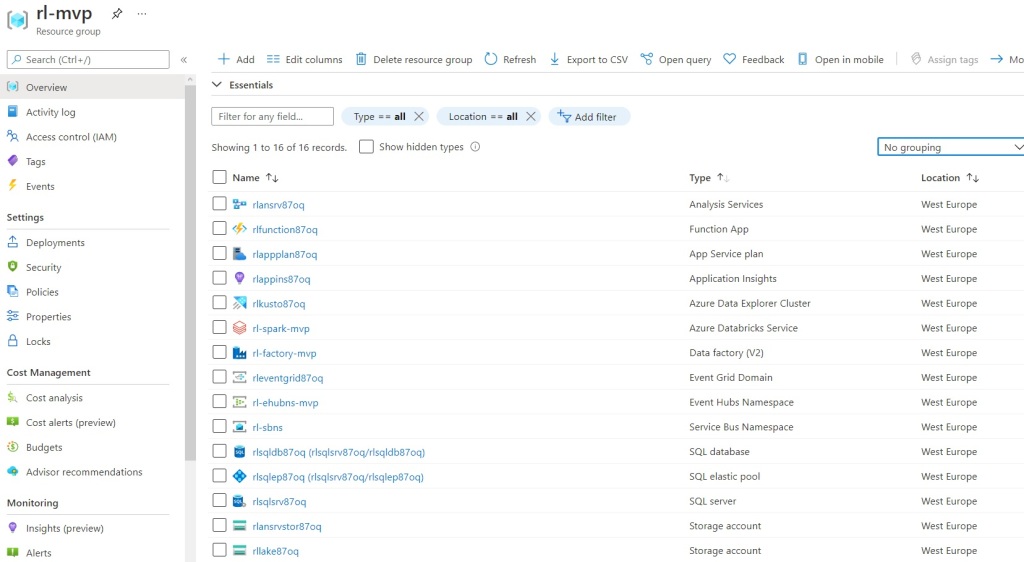Terraform-based deployment of almost all Azure Data Services (default deployment settings are in the parenthesis):
- Azure Service Bus (Standard, namespace,topic,subscription, auth. rules)
- Azure Data Lake Storage (ZRS, Hot, Secured, StandardV2)
- Azure Data Factory (w/Git or without)
- Azure Data Factory linked with Data Lake Storage
- Azure Data Factory Pipeline
- Azure DataBricks WorkSpace (Standard)
- Azure EventHub (Standard, namespace)
- Azure Functions (Dynamic, LRS storage, Python, w/App.Insights or without)
- Azure Data Explorer (Kusto, Standard_D11_v2, 2 nodes)
- Azure Analysis Server (backup-enabled, S0, LRS, Standard)
- Azure Event Grid (domain, EventGridSchema)
- Azure SQL Server (version 12.0)
- Azure SQL Database (ElasticPool SKU name, 5 GB max data size)
- Azure SQL Elastic Pool (StandardPool, LicenseIncluded, 50 eDTU/50GB)
Properties and content
- Over 1k strings and 26 terraform resources in total
- Almost every string is commented out, multiple conditions in each resource, variable conditions to check it’s value before the deployment and etc. So, it’s flexible, not hardcoded and allows you to create infrastructure with your own set of resources.
- Written a few years ago, updated once since then to fix deprecated features
- June, 2021 Update: SQL Server, Database and Elastic Pool , added variable conditions (for example, sql password must be longer than 8 symbols and have upper-case, digits and special characters), added a sensitive variable (just for sample), new Terraform 0.15.5 syntax/features were added, multiple minor changes
- Tested with the latest Terraform 0.15.5 and Azure provider 2.62.0 (the first version of the script worked fine with >=0.12 and AzureRM >=1.35, just check the syntax and try out)
- auth.tf – provider authentication and version settings
- main.tf – a desired Azure infrastructure
- terraform.tfvars – controls deployment settings
- variables.tf – variables list
- outputs.tf – outputs useful information
Deployment settings (excerpt)
#--------------------------------------------------------------
# What should be deployed?
#--------------------------------------------------------------
servicebus = true # Azure Service Bus
datafactory = true # Azure Data Factory
datafactory_git = false # Enable GIT for Data Factory? (don't forget to set Git settings in the Data Factory section)
databricks = true # Azure DataBricks
eventhub = true # Azure EventHub
functions = true # Azure Functions
functions_appins = true # Integrate App.Insights with Azure Functions?
eventgrid = true # Azure EventGrid
kusto = true # Azure Data Explorer (kusto)
analysis = true # Azure Analysis Server
sqlserver = true # Azure SQL Server
sqlep = true # Azure SQL Elastic Pool
sqldb = true # Azure SQL DatabaseResource block (excerpt)
#Azure SQL Database
resource "azurerm_mssql_database" "rlmvp-svc-sql-db" {
count = var.sqlserver == "true" && var.sqldb == "true" ? 1 : 0
name = "${var.prefix}sqldb${random_string.rndstr.result}"
elastic_pool_id = var.sqlep == "true" ? azurerm_mssql_elasticpool.rlmvp-svc-sql-elastic-pool[count.index].id : null
server_id = azurerm_sql_server.rlmvp-svc-sql-server[count.index].id
max_size_gb = var.az_sql_db_maxsize
sku_name = var.az_sql_db_sku_name
tags = var.az_tags
}Variable Conditions
variable "az_sqlserver_password" {
type = string
description = "Azure SQL Server Admin's Password"
validation {
condition = length(var.az_sqlserver_password) > 8 && can(regex("(^.*[A-Z0-9].*[[:punct:]].*$)", var.az_sqlserver_password)) # meets Azure SQL password's policy
error_message = "SQL Server Admin's password must contain more than 6 symbols (lowercase + upper-case and special/punctuation characters!)."
}
}Usage guide
- Open the terraform.tfvars file
- Indicate the “What Should Be Deployed?” section
- Use true/false to set your desired configuration
- Check or change Azure services settings in the appropriate sections (naming convention (prefix/suffix), location, SKUs and etc.)
- Run terraform init to get required Terraform providers
- Run terraform plan to initiate pre-deployment check
- Run terraform apply to start a deployment
- (optional) terraform destroy to delete Azure resources
Requirements
- The script uses Service Principal authentication, so define the subscription ID, client ID, tenand ID and principal secret in the auth.tf (or use another authentication type – Managed Identity, if your CI is running on Azure VMs, for instance)
- If you are going to deploy Analysis Server (enabled, by default), provide valid Azure AD user(s) UPN(s) to set them as administrators of Analysis Server (az_ansrv_users variable, file – terraform.tfvars)
Result


P.S. feel free to share/commit/fork/slam/sell/copy and do anything that your conscience allows you
Read more great blogs here
About the Author:
My name is Roman Levchenko and I am a Microsoft Most Valuable Professional (since 2014), VMware vExpert (2017-2019) and Senior Cloud & DevOps Engineer working for a leading international IT and development company (US-based).
Read more here.
Reference:
Levchenko, R. (2021). Deploy Azure Data Services with Terraform. Available at: https://rlevchenko.com/2020/09/15/deploy-azure-data-services-with-terraform/ [Accessed: 28th July 2021].










